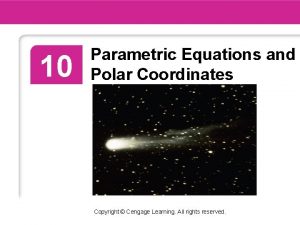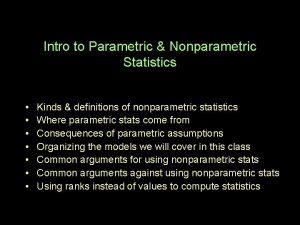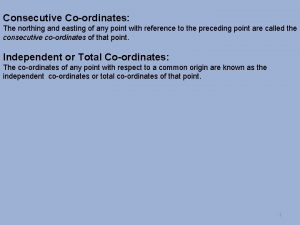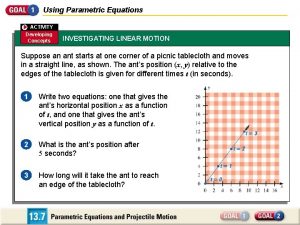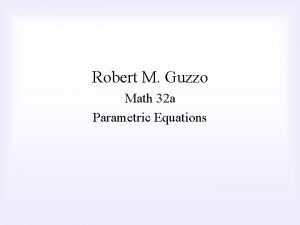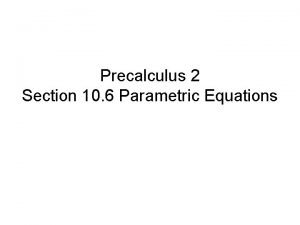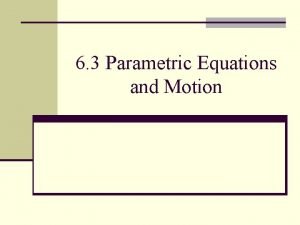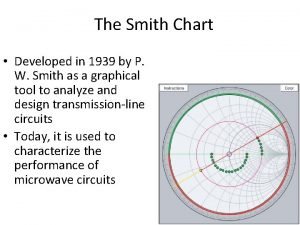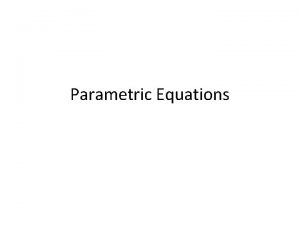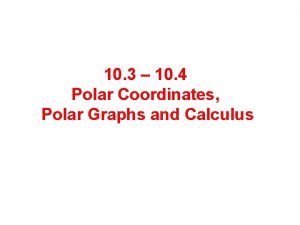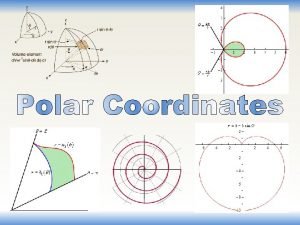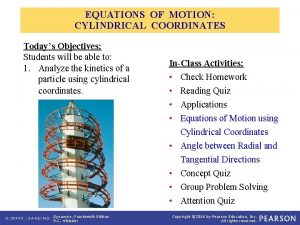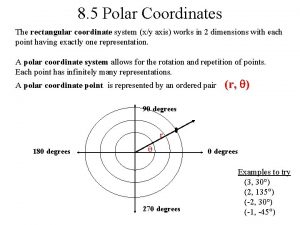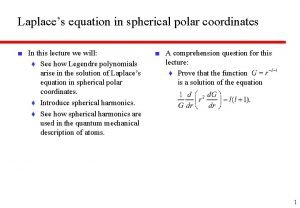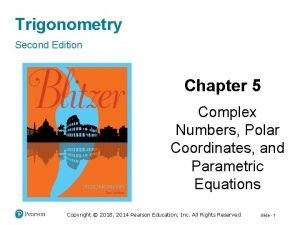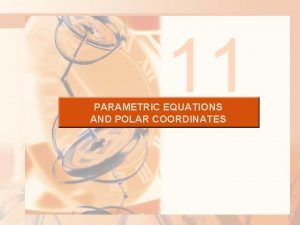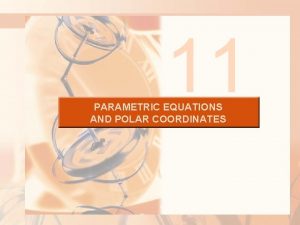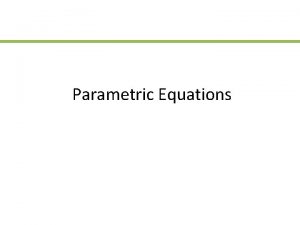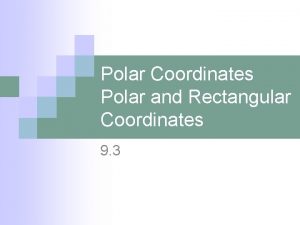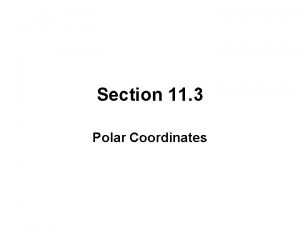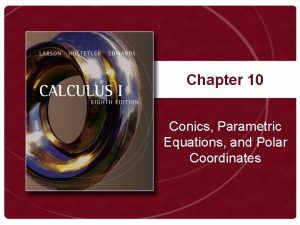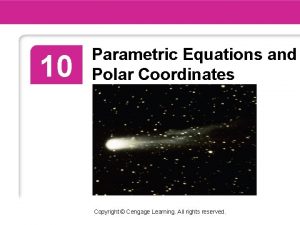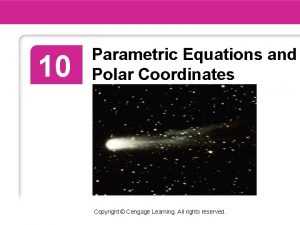Chapter 8 Polar Coordinates and Parametric Equations Stewart



































- Slides: 35

Chapter 8 Polar Coordinates and Parametric Equations Stewart, Pre. Calculus, 7 th Edition. © 2016 Cengage. All Rights Reserved. May not be scanned, copied or duplicated, or posted to a publicly accessible website, in whole or in part.

8. 2 Graphs of Polar Equations Stewart, Pre. Calculus, 7 th Edition. © 2016 Cengage. All Rights Reserved. May not be scanned, copied or duplicated, or posted to a publicly accessible website, in whole or in part.

Objectives • Graphing Polar Equations • Symmetry • Graphing Polar Equations with Graphing Devices Stewart, Pre. Calculus, 7 th Edition. © 2016 Cengage. All Rights Reserved. May not be scanned, copied or duplicated, or posted to a publicly accessible website, in whole or in part.

Graphs of Polar Equations The graph of a polar equation r = f ( ) consists of all points P that have at least one polar representation (r, ) whose coordinates satisfy the equation. Many curves that arise in mathematics and its applications are more easily and naturally represented by polar equations than by rectangular equations. Stewart, Pre. Calculus, 7 th Edition. © 2016 Cengage. All Rights Reserved. May not be scanned, copied or duplicated, or posted to a publicly accessible website, in whole or in part.

Graphing Polar Equations Stewart, Pre. Calculus, 7 th Edition. © 2016 Cengage. All Rights Reserved. May not be scanned, copied or duplicated, or posted to a publicly accessible website, in whole or in part.

Graphing Polar Equations (1 of 5) A rectangular grid is helpful for plotting points in rectangular coordinates (see Figure 1(a)). To plot points in polar coordinates, it is convenient to use a grid consisting of circles centered at the pole and rays emanating from the pole, as in Figure 1(b). (b) Grid for polar coordinates (a) Grid for rectangular coordinates Figure 1 Stewart, Pre. Calculus, 7 th Edition. © 2016 Cengage. All Rights Reserved. May not be scanned, copied or duplicated, or posted to a publicly accessible website, in whole or in part.

Graphing Polar Equations (2 of 5) We will use such grids to help us sketch polar graphs. In Example 1 we see that circles centered at the origin and lines that pass through the origin have particularly simple equations in polar coordinates. Stewart, Pre. Calculus, 7 th Edition. © 2016 Cengage. All Rights Reserved. May not be scanned, copied or duplicated, or posted to a publicly accessible website, in whole or in part.

Example 1 – Sketching the Graph of a Polar Equation Sketch a graph of the equation r = 3, and express the equation in rectangular coordinates. Solution: The graph consists of all points whose r-coordinate is 3, that is, all points that are 3 units away from the origin. Stewart, Pre. Calculus, 7 th Edition. © 2016 Cengage. All Rights Reserved. May not be scanned, copied or duplicated, or posted to a publicly accessible website, in whole or in part.

Example 1 – Solution (1 of 2) So the graph is a circle of radius 3 centered at the origin, as shown in Figure 2 Stewart, Pre. Calculus, 7 th Edition. © 2016 Cengage. All Rights Reserved. May not be scanned, copied or duplicated, or posted to a publicly accessible website, in whole or in part.

Example 1 – Solution (2 of 2) Squaring both sides of the equation, we get Square both sides So the equivalent equation in rectangular coordinates is Stewart, Pre. Calculus, 7 th Edition. © 2016 Cengage. All Rights Reserved. May not be scanned, copied or duplicated, or posted to a publicly accessible website, in whole or in part.

Graphing Polar Equations (3 of 5) In general, the graphs of equations of the form are circles with radius and (a, 0), respectively. centered at the points with polar coordinates Stewart, Pre. Calculus, 7 th Edition. © 2016 Cengage. All Rights Reserved. May not be scanned, copied or duplicated, or posted to a publicly accessible website, in whole or in part.

Example 4 – Sketching the Graph of a Cardioid Sketch a graph of r = 2 + 2 cos . Solution: We first sketch the graph of r = 2 + 2 cos in rectangular coordinates in Figure 5. r = 2 + 2 cos Figure 5 Stewart, Pre. Calculus, 7 th Edition. © 2016 Cengage. All Rights Reserved. May not be scanned, copied or duplicated, or posted to a publicly accessible website, in whole or in part.

Example 4 – Solution (1 of 3) We can think of this graph as a table of values that enables us to read at a glance the values of r that correspond to increasing values of . For instance, we see that as increases from 0 to r (the distance from O) decreases from 4 to 2, so we sketch the corresponding part of the polar graph in Figure 6(a). (a) Steps in sketching r = 2 + 2 cos Figure 6 Stewart, Pre. Calculus, 7 th Edition. © 2016 Cengage. All Rights Reserved. May not be scanned, copied or duplicated, or posted to a publicly accessible website, in whole or in part.

Example 4 – Solution (2 of 3) As increases from to , Figure 5 shows that r decreases from 2 to 0, so we sketch the next part of the graph as in Figure 6(b). As increases from to r increases from 0 to 2, as shown in part (c) (b) Steps in sketching r = 2 + 2 cos Figure 6 Stewart, Pre. Calculus, 7 th Edition. © 2016 Cengage. All Rights Reserved. May not be scanned, copied or duplicated, or posted to a publicly accessible website, in whole or in part.

Example 4 – Solution (3 of 3) Finally, as increases from to 2 , r increases from 2 to 4, as shown in part (d). If we let increase beyond 2 or decrease beyond 0, we would simply retrace our path. Combining the portions of the graph from parts (a) through (d) of Figure 6, we sketch the complete graph in part (e) (d) Steps in sketching r = 2 + 2 cos Figure 6 Stewart, Pre. Calculus, 7 th Edition. © 2016 Cengage. All Rights Reserved. May not be scanned, copied or duplicated, or posted to a publicly accessible website, in whole or in part.

Graphing Polar Equations (4 of 5) The curve in Figure 6 is called a cardioid because it is heart-shaped. In general, the graph of any equation of the form is a cardioid. Stewart, Pre. Calculus, 7 th Edition. © 2016 Cengage. All Rights Reserved. May not be scanned, copied or duplicated, or posted to a publicly accessible website, in whole or in part.

Example 5 – Sketching the Graph of a Four. Leaved Rose Sketch the curve r = cos 2. Solution: As in Example 4, we first sketch the graph of r = cos 2 in rectangular coordinates, as shown in Figure 7. Graph of r = cos 2 sketched in rectangular coordinates Figure 7 Stewart, Pre. Calculus, 7 th Edition. © 2016 Cengage. All Rights Reserved. May not be scanned, copied or duplicated, or posted to a publicly accessible website, in whole or in part.

Example 5 – Solution (1 of 2) As increases from 0 to Figure 7 shows that r decreases from 1 to 0, so we draw the corresponding portion of the polar curve in Figure 8 (indicated by As increases from ) the value of r goes from 0 to − 1. Four-leaved rose r = cos 2 sketched in polar coordinates Figure 8 Stewart, Pre. Calculus, 7 th Edition. © 2016 Cengage. All Rights Reserved. May not be scanned, copied or duplicated, or posted to a publicly accessible website, in whole or in part.

Example 5 – Solution (2 of 2) This means that the distance from the origin increases from 0 to 1, but instead of being in Quadrant I, this portion of the polar curve (indicated by ) lies on the opposite side of the origin in Quadrant III. The remainder of the curve is drawn in a similar fashion, with the arrows and numbers indicating the order in which the portions are traced out. The resulting curve has four petals and is called a four-leaved rose. Stewart, Pre. Calculus, 7 th Edition. © 2016 Cengage. All Rights Reserved. May not be scanned, copied or duplicated, or posted to a publicly accessible website, in whole or in part.

Graphing Polar Equations (5 of 5) In general, the graph of an equation of the form is an n-leaved rose if n is odd or a 2 n-leaved rose if n is even (as in Example 5). Stewart, Pre. Calculus, 7 th Edition. © 2016 Cengage. All Rights Reserved. May not be scanned, copied or duplicated, or posted to a publicly accessible website, in whole or in part.

Symmetry Stewart, Pre. Calculus, 7 th Edition. © 2016 Cengage. All Rights Reserved. May not be scanned, copied or duplicated, or posted to a publicly accessible website, in whole or in part.

Symmetry (1 of 5) In graphing a polar equation, it’s often helpful to take advantage of symmetry. We list three tests for symmetry; Figure 9 shows why these tests work. (a) Symmetry about the polar axis (b) Symmetry about the pole Figure 9 Stewart, Pre. Calculus, 7 th Edition. © 2016 Cengage. All Rights Reserved. May not be scanned, copied or duplicated, or posted to a publicly accessible website, in whole or in part.

Symmetry (2 of 5) TESTS FOR SYMMETRY 1. If a polar equation is unchanged when we replace θ by −θ , then the graph is symmetric about the polar axis (Figure 9(a)). 2. If the equation is unchanged when we replace r by −r, or θ by θ − , then the graph is symmetric about the pole (Figure 9(b)). 3. If the equation is unchanged when we replace θ by − θ , then the graph is symmetric about the vertical line (the y-axis) (Figure 9(c)). Stewart, Pre. Calculus, 7 th Edition. © 2016 Cengage. All Rights Reserved. May not be scanned, copied or duplicated, or posted to a publicly accessible website, in whole or in part.

Symmetry (3 of 5) The graphs in Figures 2, 6(e), and 8 are symmetric about the polar axis. The graph in Figure 8 is also symmetric about the pole. Figures 4 and 8 show graphs that are symmetric about Figure 2 Steps in sketching r = 2 + 2 cos Figure 6(e) Four-leaved rose r = cos 2 sketched in polar coordinates Figure 8 Stewart, Pre. Calculus, 7 th Edition. © 2016 Cengage. All Rights Reserved. May not be scanned, copied or duplicated, or posted to a publicly accessible website, in whole or in part.

Symmetry (4 of 5) Figure 4 Note that the four-leaved rose in Figure 8 meets all three tests for symmetry. In rectangular coordinates the zeros of the function y = f (x) correspond to the xintercepts of the graph. In polar coordinates the zeros of the function r = f ( ) are the angles at which the curve crosses the pole. The zeros help us sketch the graph, as is illustrated in the next example. Stewart, Pre. Calculus, 7 th Edition. © 2016 Cengage. All Rights Reserved. May not be scanned, copied or duplicated, or posted to a publicly accessible website, in whole or in part.

Example 6 – Using Symmetry to Sketch a Limaçon Sketch a graph of the equation r = 1 + 2 cos . Solution: We use the following as aids in sketching the graph. Symmetry. Since the equation is unchanged when is replaced by – , the graph is symmetric about the polar axis. Stewart, Pre. Calculus, 7 th Edition. © 2016 Cengage. All Rights Reserved. May not be scanned, copied or duplicated, or posted to a publicly accessible website, in whole or in part.

Example 6 – Solution (1 of 2) Zeros. To find the zeros, we solve 0 = 1 + 2 cos Table of values. As in Example 4, we sketch the graph of r = 1 + 2 cos in rectangular coordinates to serve as a table of values (Figure 10). Figure 10 Stewart, Pre. Calculus, 7 th Edition. © 2016 Cengage. All Rights Reserved. May not be scanned, copied or duplicated, or posted to a publicly accessible website, in whole or in part.

Example 6 – Solution (2 of 2) Now we sketch the polar graph of r = 1 + 2 cos from = 0 to = and then use symmetry to complete the graph in Figure 11. r = 1 + 2 cos Figure 11 Stewart, Pre. Calculus, 7 th Edition. © 2016 Cengage. All Rights Reserved. May not be scanned, copied or duplicated, or posted to a publicly accessible website, in whole or in part.

Symmetry (5 of 5) The curve in Figure 11 is called a limaçon, after the Middle French word for snail. In general, the graph of an equation of the form is a limaçon. The shape of the limaçon depends on the relative size of a and b. Stewart, Pre. Calculus, 7 th Edition. © 2016 Cengage. All Rights Reserved. May not be scanned, copied or duplicated, or posted to a publicly accessible website, in whole or in part.

Graphing Polar Equations with Graphing Devices Stewart, Pre. Calculus, 7 th Edition. © 2016 Cengage. All Rights Reserved. May not be scanned, copied or duplicated, or posted to a publicly accessible website, in whole or in part.

Graphing Polar Equations with Graphing Devices (1 of 3) Although it’s useful to be able to sketch simple polar graphs by hand, we need a graphing calculator or computer when the graph is as complicated as the one in Figure 12. Fortunately, most graphing calculators are capable of graphing polar equations directly. Figure 12 Stewart, Pre. Calculus, 7 th Edition. © 2016 Cengage. All Rights Reserved. May not be scanned, copied or duplicated, or posted to a publicly accessible website, in whole or in part.

Example 7 – Drawing the Graph of a Polar Equation (1 of 2) Graph the equation Solution: We need to determine the domain for . So we ask ourselves: How many times must go through a complete rotation (2 radians) before the graph starts to repeat itself? The graph repeats itself when the same value of r is obtained at and + 2 n. Thus we need to find an integer n so that Stewart, Pre. Calculus, 7 th Edition. © 2016 Cengage. All Rights Reserved. May not be scanned, copied or duplicated, or posted to a publicly accessible website, in whole or in part.

Example 7 – Drawing the Graph of a Polar Equation (2 of 2) For this equality to hold, must be a multiple of 2 , and this first happens when n = 3. Therefore we obtain the entire graph if we choose values of between = 0 and = 0 + 2(3) = 6. The graph is shown in Figure 13 Stewart, Pre. Calculus, 7 th Edition. © 2016 Cengage. All Rights Reserved. May not be scanned, copied or duplicated, or posted to a publicly accessible website, in whole or in part.

Graphing Polar Equations with Graphing Devices (2 of 3) The box below gives a summary of some of the basic polar graphs used in calculus. SOME COMMON POLAR CURVES Circles and Spiral Limaçons r = a ± b sin u r = a ± b cos u (a > 0, b > 0) Orientation depends on the trigonometric function (sine or cosine) and the sign of b. r=a circle r = a sin θ circle r = a cos θ circle r = aθ spiral a<b limaçon with inner loop a=b cardioid a>b dimpled limaçon a ≥ 2 b convex limaçon Stewart, Pre. Calculus, 7 th Edition. © 2016 Cengage. All Rights Reserved. May not be scanned, copied or duplicated, or posted to a publicly accessible website, in whole or in part.

Graphing Polar Equations with Graphing Devices (3 of 3) SOME COMMON POLAR CURVES Roses r = a sin nu r = a cos nu n-leaved if n is odd 2 n-leaved if n is even r = a cos 2θ 4 -leaved rose r = a cos 3θ 3 -leaved rose r = a cos 4θ 8 -leaved rose r = a cos 5θ 5 -leaved rose Lemniscates Figure-eight-shaped curves. Stewart, Pre. Calculus, 7 th Edition. © 2016 Cengage. All Rights Reserved. May not be scanned, copied or duplicated, or posted to a publicly accessible website, in whole or in part.
 Parametric equations and polar coordinates
Parametric equations and polar coordinates Converting polar coordinates to rectangular coordinates
Converting polar coordinates to rectangular coordinates Bmk+
Bmk+ Parametric and nonparametric tests
Parametric and nonparametric tests Parametric and non parametric algorithms
Parametric and non parametric algorithms Parametric vs non parametric test
Parametric vs non parametric test Chapter 7 conic sections and parametric equations
Chapter 7 conic sections and parametric equations Consecutive and independent coordinates in surveying
Consecutive and independent coordinates in surveying Cho hang
Cho hang Rectangular and polar coordinates
Rectangular and polar coordinates In a pumpkin tossing contest in morton illinois
In a pumpkin tossing contest in morton illinois Parametric equations word problems
Parametric equations word problems Parametric equations
Parametric equations Parametric equation of motion
Parametric equation of motion How to solve parametric equations
How to solve parametric equations Smith chart parametric equations
Smith chart parametric equations Parametric equations
Parametric equations Dr frost parametric equations
Dr frost parametric equations Arc length of polar curve
Arc length of polar curve Pole in polar coordinates
Pole in polar coordinates Polar axis and pole
Polar axis and pole Polar plot wolfram alpha
Polar plot wolfram alpha Polar coordinates
Polar coordinates Geodesic polar coordinates
Geodesic polar coordinates Polar fourier series
Polar fourier series Polar coordinates dynamics examples
Polar coordinates dynamics examples How to add in polar form
How to add in polar form Polar coordinates symmetry
Polar coordinates symmetry Y=rsin
Y=rsin Type of conic
Type of conic Limit and continuity
Limit and continuity Polar coordinates to rectangular
Polar coordinates to rectangular Polar integrals
Polar integrals Laplace equation in spherical polar coordinates
Laplace equation in spherical polar coordinates Conic section in polar coordinates
Conic section in polar coordinates How to find rectangular coordinates
How to find rectangular coordinates
